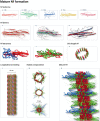The 2022 Lady Estelle Wolfson lectureship on neurofilaments
- PMID: 35950263
- PMCID: PMC9826399
- DOI: 10.1111/jnc.15682
The 2022 Lady Estelle Wolfson lectureship on neurofilaments
Abstract
Neurofilament proteins (Nf) have been validated and established as a reliable body fluid biomarker for neurodegenerative pathology. This review covers seven Nf isoforms, Nf light (NfL), two splicing variants of Nf medium (NfM), two splicing variants of Nf heavy (NfH), -internexin (INA) and peripherin (PRPH). The genetic and epigenetic aspects of Nf are discussed as relevant for neurodegenerative diseases and oncology. The comprehensive list of mutations for all Nf isoforms covers Amyotrophic Lateral Sclerosis, Charcot-Marie Tooth disease, Spinal muscular atrophy, Parkinson Disease and Lewy Body Dementia. Next, emphasis is given to the expanding field of post-translational modifications (PTM) of the Nf amino acid residues. Protein structural aspects are reviewed alongside PTMs causing neurodegenerative pathology and human autoimmunity. Molecular visualisations of NF PTMs, assembly and stoichiometry make use of Alphafold2 modelling. The implications for Nf function on the cellular level and axonal transport are discussed. Neurofilament aggregate formation and proteolytic breakdown are reviewed as relevant for biomarker tests and disease. Likewise, Nf stoichiometry is reviewed with regard to in vitro experiments and as a compensatory mechanism in neurodegeneration. The review of Nf across a spectrum of 87 diseases from all parts of medicine is followed by a critical appraisal of 33 meta-analyses on Nf body fluid levels. The review concludes with considerations for clinical trial design and an outlook for future research.
Keywords: biomarker; diagnosis; neurofilament; prognosis; treatment trial.
© 2022 The Author. Journal of Neurochemistry published by John Wiley & Sons Ltd on behalf of International Society for Neurochemistry.
Conflict of interest statement
The author declares no conflict of interest.
Figures



References
-
- Aamodt, A. H. , Høgestøl, E. A. , Popperud, T. H. , Holter, J. C. , Dyrhol‐Riise, A. M. , Tonby, K. , Stiksrud, B. , Quist‐Paulsen, E. , Berge, T. , Barratt‐Due, A. , Aukrust, P. , Heggelund, L. , Blennow, K. , Zetterberg, H. , & Harbo, H. F. (2021). Blood neurofilament light concentration at admittance: A potential prognostic marker in COVID‐19. Journal of Neurology, 268, 3574–3583. - PMC - PubMed
-
- Abaroa, L. , Rodrguez‐Quiroga, S. A. , Melamud, L. , Arakaki, T. , Garretto, N. S. , & Villa, A. M. (2013). Tonic spasms are a common clinical manifestation in patients with neuromyelitis optica. Arquivos de Neuro‐Psiquiatria, 71, 280–283. - PubMed
-
- Abdelhak, A. , Cordano, C. , Boscardin, W. J. , Caverzasi, E. , Kuhle, J. , Chan, B. , Gelfand, J. M. , Yiu, H. H. , Oertel, F. C. , Beaudry‐Richard, A. , Montes, S. C. , Oksenberg, J. R. , Lago, A. L. , Boxer, A. , Rojas‐Martinez, J. C. , Elahi, F. M. , Chan, J. R. , & Green, A. J. (2022). Plasma neurofilament light chain levels suggest neuroaxonal stability following therapeutic remyelination in people with multiple sclerosis. Journal of Neurology, Neurosurgery, and Psychiatry, 18, 158–172 - PMC - PubMed
-
- Adzick, N. S. , Thom, E. A. , Spong, C. Y. , Brock, J. W. , Burrows, P. K. , Johnson, M. P. , Howell, L. J. , Farrell, J. A. , Dabrowiak, M. E. , Sutton, L. N. , Gupta, N. , Tulipan, N. B. , D’Alton, M. E. , & Farmer, D. L. (2011). A randomized trial of prenatal versus postnatal repair of myelomeningocele. New England Journal of Medicine, 364, 993–1004. - PMC - PubMed
Publication types
MeSH terms
Substances
LinkOut - more resources
Full Text Sources
Medical
Miscellaneous

